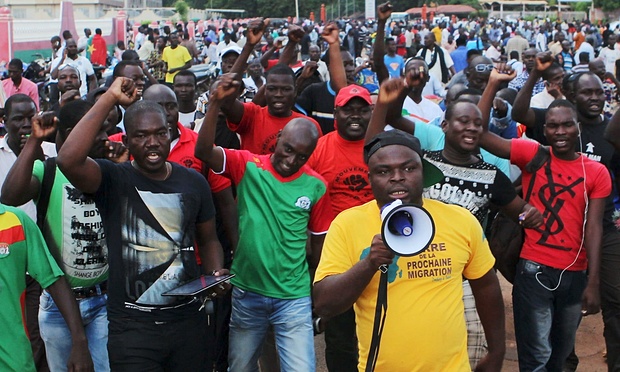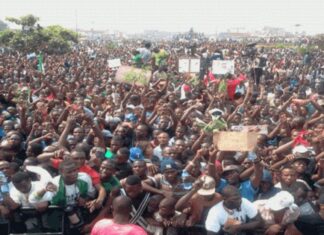“The handsome Blaise” (Compaoré), as global diplomats called him, is not coming back; neither are his lieutenants. His old Praetorian guard, the RSP (Regiment of Presidential Security), is now dissolved. Two of his allies, General Gilbert Diendéré and former Minister Djibril Bassolé, have been arrested in Burkina Faso for “attacking the security of the state “. At least in theory, they face severe penalties.
This was the result of the aborted coup attempt that began on 17 September 2015 in Ouagadougou. A fraction of the army took leaders of the transitional government hostage, the interim president Michel Kafando and Prime Minister Isaac Zida (organizing a transition after the departure of Compaoré in 2014). But the putschists obviously had vastly underrated the capacity for popular resistance.
Compaoré in Cote d’Ivoire
A pampered friend of world powers – especially France – and an autocrat who stayed in power in Burkina Faso for 27 years, the former President Blaise Compaoré dreamed of a return from neighbouring Ivory Coast.
He had been welcomed with open arms by the head of state Alassane Ouattara, who, remember, was greatly helped by France to gain the Presidential throne (after the French army ousted his predecessor, Laurent Gbagbo, from the presidential residence on April 11, 2011).
According to witnesses who spoke to “Afrique en Lutte”, two days before the coup in Burkina Faso, the environment around the Ivorian home of the exiled Blaise Compaoré was suddenly animated. Many Ivorian military arrived. This provides an indication of the direct involvement of the exiled autocrat.
Blaise Compaoré had long been presented by politicians and some of the media, as a moderate and reasonable president in an unstable region. He was a negotiator in many conflicts – elections in Guinea in 2010, conflict in Côte d’Ivoire in 2010/11, civil war in Mali in 2012/13 … – where he often had interests with one side rather than another, he was far from being a disinterested mediator. As an example: during the cruel civil wars in Liberia and Sierra Leone, around the year 2000, Burkina Faso came to the world markets as an exporter of diamonds… when it does not produce any itself. These were what is commonly called “blood diamonds”. The Burkina Faso regime was also a hub for arms trafficking throughout West Africa.
The right arm of President Compaoré, his chief of staff, Diendéré Gilbert, was the subject of a United Nations investigation from 2005, regarding his role in Liberia. The same Diendéré, was awarded the Legion of Honour of the French Republic, in 2008.
The same Gilbert Diendéré was head of the coup of 17 September 2015. He wanted to take the country back to before 31 October, 2014.
October 31, 2014
On that day, Blaise Compaoré fell due to the outrageousness of his ambitions. The country’s constitution limits the number of presidential terms, but he had been the incumbent president since 1987 (and the assassination of his predecessor, Thomas Sankara). Compaoré tried to overturn this restriction by convening a Parliamentary Assembly, mainly of his supporters in the ruling party – the CDP, Congress for Democracy and Progress”. Rumours of this proposal had given rise to splits including the People’s Movement for Progress. This new movement was founded by politicians feared the end the regime and wished to leave ship before it sank, without fundamentally questioning the established social order.
It was not the official opposition parties, but a popular movement which swept away the Compaoré regime. The Citizen’s Broom, supported by two popular musicians, Smockey and Sams’K Le Jah, called for demonstrations against the constitutional amendment. On the day of the vote, 31, October 2014, the farce of Parliament was interrupted by angry demonstrations who attacked the official buildings.
The repression resulted in thirty demonstrators being killed, but President Compaoré was obliged to “resign” and a French army helicopter removed him to Côte d’Ivoire. The French public learned that an elite command of the French Army, had a base in Ouagadougou, thanks to Compaoré.
September 2015
On announcing the coup on 16 September 2015, spontaneous opposition demonstrations once again took place in the streets of the capital. A radio station, Radio de la Résistance Citoyenne (Citizen’s Resistance Radio), was set up to call on activists to take action and trade unions announced a general nationwide strike.
From the beginning, teachers went on strike and Séma Blegne, the national General Secretary of the SNEAB, one of the teachers’ trade unions called on “the Burkinabé people to tap into their long tradition of organisation, resistance and struggle to defeat the military coup” and “activists of all of its unions to mobilise and resist until the military junta that staged the coup surrenders”.
Coordinating bodies composed of trade unions, political parties and the civil society were set up in each region because “we were in a war situation”, army officials had to take responsibility due to the significant mobilisation in the regions.
A reactionary coup
The core of the coup was the Regiment of Presidential Security (RSP), an elite troop of 1,300, now dissolved. The RSP had been created as a personal guard under the direct orders of President Compaoré and given rich privileges, tanks and heavy weapons. Earlier this year, it openly became involved in politics, demanding in early July 2015 the departure of the transitional Prime Minister, Isaac Zida. He had been the deputy leader of the RSP, but resigned to pursue a ‘clean’ political agenda and so was considered a “traitor”.
The main target of the coup were the regulations for the presidential and legislative elections, originally scheduled October (and now delayed until at least November/ December 2015 and perhaps early 2016).
These regulations prevented senior officials of the former regime, at least those who had actively promoted the Constitutional change for Compaoré, from standing in the coming elections. Three leaders of the old regime had overcome these restrictions, but were facing further court cases.
These cases also involved immunity for criminals of the Compaoré era. Political heavyweights and those who had enriched themselves sought protection against prosecution by being presidential candidates or gaining a parliamentary seat. This may have allowed them to escape prosecution due to their ‘respectability’ or the balance of political forces.
Fractured army
The attempt to take the country back clearly failed. It was broken by popular resistance, but also by sections of the army. But the essential conflict is still coming. What is of most interest to the masses, is less the elections – which many Burkinabe do not expect to bring a big change to their daily lives – but the risk of an amnesty for economic crimes and the old political elite. The risk of impunity, particularly for financial crimes, remains real, as does the continuation of exploitation by local and neo-colonial elites.
The United States is now a great rival to French imperialism in Africa (next to the China, which remains mostly silent on “internal political affairs” of countries where it gains in economic influence). Among the military units opposed to the coup, some were formed earlier by the US military. For the United States, this provided a counterweight to French influence. However, both the main candidates for the presidential elections have been received by the French Socialist Party (currently in government in France).
The weight of history
Burkina Faso, although ranked among the ten least developed countries in the world, has a population who “does do not let things be”. It has strong political traditions of popular mobilization, partly related to the Sankara era, which were clear during the coup attempt.
Shortly before 1900, the Kingdom of Ouagadougou, corresponding more or less to the current Burkina Faso, became part the “French West Africa” (AOF) and was called Upper Volta. Large popular mobilizations took place in 1915 and 1916 against forced recruitment to the French army, leading to the “war of Bani Volta”. Between 1932 and 1947, the territory was merged with the current Ivory Coast. This why today, millions Burkinabe nationals – from one or more generations – reside in Ivory Coast.
During the revolutionary era (1983-1987), the country was led by Thomas Sankara, who is still a hero for many youth across West Africa. He introduced many reforms to reduce poverty, hunger and to improve the position of women. But, for example, he sacked striking teachers and so lost much of his popular support.
In a more recent period, popular mobilizations have left deep traces most recently against the reactionary coup. These protests included those over the assassination the journalist Norbert Zongo (1998), which lasted for a year and forced President Compaoré to make ‘democratic’ reforms to the Constitution.
In February 2011, it was the death of a young student, Justin Zongo (no relation) in the city of Koudougou that ignited the revolt. Spurred by revolts in Tunisia and Egypt – which had then freshly removed their dictators – the youth and high school student went into the streets with the slogans ” Koudougou will be Tunisia!” Or:” Burkina will have its Egypt!” In many cities, administrative buildings (police, courts, town halls) burned. In the city of Ouhigouya, burning police ammunition caused a series of explosions that lasted seventeen minutes. This was followed by an explosion of a different nature, a social explosion. From mid-March 2011, the student movement took over the capital Ouagadougou, with mass demonstrations. There were also strikes: by teachers, the phone company ONATEL and in the gold mine Kalsaka (see AEL Bulletin # 27 and http://tahinparty.org/chouli.html).
Down with the Presidential Guard
But there will also clashes within the army. In mid-April 2011, it is primarily the RSP, elite troop, which revolts for reasons hardware of its own: against loss some premiums related to operations external (Darfur, Ivory Coast ..). But in the end May this be the basic forces that revolt in Bobo Dioulasso before being … repressed by the RSP, by the orders of the regime. It shows above all the deep cleavages class that also exist within the army.
These events contributed significantly to weaken the Compaoré regime, which fell during the next wave of mobilizations in autumn 2014 and foreshadowed the end. The popular masses of Burkina Faso have this year again been successful against the reactionary coup.
These events are important, not only in Burkina Faso, but in other countries where corrupt elites are struggling to stay in power. These include, for example, Joseph Kabila in the Democratic Republic of Congo, Sassou N’Guesso in Congo Brazzaville and Pierre Nkurunziza in Burundi.
Translated from the French article in Afrique en lute by Berthold From Ryon









